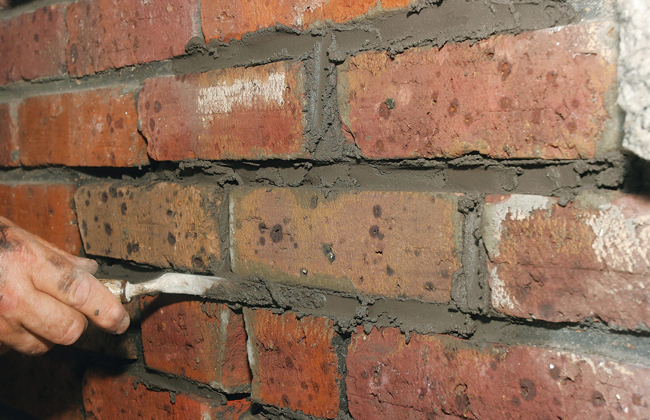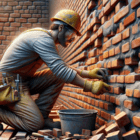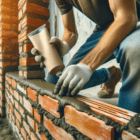When it comes to maintaining the structural integrity of your home, understanding how to repair cracks in brick walls is crucial. These cracks can be more than just an eyesore; they can also signify underlying issues that need immediate attention. This guide aims to provide homeowners with detailed and effective methods for identifying, preparing, and repairing various types of cracks in brick walls, ensuring the longevity and safety of their homes.
Table of Contents
Understanding the Causes of Cracks in Brick Walls
Cracks in brick walls can arise from a variety of sources, ranging from natural aging of the building to environmental factors. Understanding these causes is crucial for effective repair. Structural settling often results in minor cracks as the building adjusts over time. Temperature fluctuations cause expansion and contraction in the bricks and mortar, leading to cracks. Moisture issues, particularly water seeping into the bricks and freezing, can cause significant damage. Poor construction techniques or materials can also lead to weaknesses in the wall. Identifying the type of crack and its cause is essential in determining the appropriate repair method.
Identifying Different Types of Cracks
Hairline Cracks:
Small, thin cracks, often due to settling or minor temperature changes, are known as hairline cracks. These are the most common and least concerning types of cracks in brick walls. They typically occur when the house settles over time or when there are minor shifts in the foundation. Although they’re not usually a sign of structural issues, it’s important to monitor them to ensure they don’t widen over time.
Stair-Step Cracks:
These cracks follow the mortar joints in a stair-step pattern and are usually a sign of foundation issues. They are more concerning than hairline cracks as they can indicate movement or settling in the foundation of your home. If the stair-step cracks are wide or accompanied by other signs of foundation trouble, such as doors or windows that won’t close properly, it’s crucial to consult a professional.
Horizontal Cracks:
Horizontal cracks are serious indicators of structural problems, often due to soil pressure against the wall. These cracks are more severe than stair-step or hairline cracks and require immediate attention. They can be caused by hydrostatic pressure, which occurs when water accumulates in the soil around the foundation, expanding the soil and exerting pressure on the walls.
Vertical Cracks:
These can vary in severity, depending on their width and location. Narrow vertical cracks might simply be caused by minor settlement or drying shrinkage of the materials. However, wider cracks, especially those wider than 1/4 inch, could signify more significant issues, such as severe foundation movement or damage.
Common Causes of Cracks:
- Structural Settling: Over time, buildings settle, causing minor cracks.
- Temperature Fluctuations: The expansion and contraction of bricks and mortar due to heat and cold can lead to cracks.
- Moisture Issues: Water seeping into bricks and mortar can cause damage when it freezes and expands.
- Poor Construction: Inadequate materials or techniques during the building process can lead to weaknesses in the wall, resulting in cracks.
Preparing for Brick Wall Repair
Before beginning any repair work, it’s important to prepare adequately. This includes ensuring safety by wearing appropriate protective gear such as goggles, gloves, and a dust mask. The area around the repair site should be secured to prevent accidents. Gathering all necessary tools and materials in advance, such as a chisel, hammer, wire brush, mortar mix, trowel, masonry sealant, and measuring tools, will streamline the repair process. A thorough inspection of the wall is also crucial to assess the extent and type of damage and to determine if professional help is needed, especially for more severe or structural issues.
Safety First:
- Wear protective gear – Protective gear is essential. Ensure you wear goggles to protect your eyes from dust and debris, gloves to protect your hands, and a dust mask to prevent inhalation of fine particles.
- Secure the area – Make sure the area is safe and secure. Remove any objects that might hinder your movement and ensure that no one is at risk during the repair process.
Tools and Materials Needed:
- Chisel and hammer – For removing loose or damaged mortar.
- Wire brush – To clean the cracks and surrounding area of debris and dust.
- Mortar mix – Choose a mortar mix that matches the existing mortar in color and texture.
- Trowel – For applying and smoothing the mortar.
- Masonry sealant – To seal the repaired area and protect it from water and weather damage.
- Measuring tools – To accurately assess the size and depth of the cracks.
Inspecting the Wall:
- Check the extent of the damage – Carefully examine the wall to understand how extensive the damage is.
- Determine the type of cracks – Identify whether the cracks are hairline, stair-step, horizontal, or vertical, as this will dictate your approach to repair.
- Assess if professional help is needed – For significant structural issues, especially in the case of horizontal cracks, professional assessment and repair might be necessary.
Step-by-Step Guide to Repairing Cracks in Brick Walls

Repairing cracks in brick walls involves a methodical approach. For hairline cracks, the process includes cleaning the crack, applying mortar, and smoothing it out. Stair-step cracks require removing loose mortar, cleaning the area, repointing the joints with new mortar, and finishing the surface. Horizontal and vertical cracks might need a different approach, often requiring professional assessment, especially if the cracks indicate structural problems. Following these steps carefully will ensure a more durable and aesthetically pleasing repair.
Repairing Hairline Cracks:
- Clean the crack with a wire brush – Remove any loose material and dust from the crack.
- Apply a thin layer of mortar using a trowel – Carefully fill the crack with mortar, ensuring it’s well-packed.
- Smooth out and let it dry – Use the flat edge of the trowel to smooth the mortar, then let it cure as per the manufacturer’s instructions.
Fixing Stair-Step Cracks:
- Remove loose mortar using a chisel and hammer – Carefully chisel out any loose or damaged mortar without damaging the bricks.
- Clean the area thoroughly – Use a wire brush to remove all dust and debris from the area.
- Repoint the joints with new mortar – Fill the joints with new mortar, pressing it in firmly.
- Smooth and finish the surface – Use a trowel to smooth the mortar and ensure it’s flush with the existing surface.
Addressing Horizontal and Vertical Cracks:
- Consult a structural engineer for horizontal cracks – Due to their severity, these cracks often require professional assessment.
- For vertical cracks, follow similar steps as for hairline and stair-step cracks, depending on the severity. Wider cracks may need more extensive repair.
Post-Repair Tips
After repairing cracks in brick walls, it’s important to apply a masonry sealant for added protection against elements like water and extreme temperatures. Regular maintenance, including routine inspections and timely repairs of new or worsening cracks, can significantly extend the life of brick walls. In cases of recurring or severe issues, especially those indicating potential structural damage, consulting with a professional is advised for a thorough assessment and appropriate repair strategies.
Applying Sealant:
Once the mortar is dry, apply a masonry sealant to the repaired area. This helps protect the repair from water infiltration and weather-related damage.
Regular Maintenance:
Regular inspection and maintenance of brick walls are crucial to prevent future damage. Look for new cracks or changes in existing cracks, and address issues promptly.
Professional Assessment:
For recurring or severe issues, it’s wise to seek professional advice. This is especially important for horizontal cracks, which can indicate serious structural problems.
Conclusion:
In conclusion, knowing how to repair cracks in brick walls is an invaluable skill for any homeowner. Regular maintenance and timely repairs not only enhance the aesthetic appeal of your home but also prevent potential structural issues. By following the steps outlined in this guide, you can effectively address and fix cracks in brick walls, ensuring the durability and strength of your home for years to come.
FAQs:
Q: How often should I check for cracks in brick walls?
A: It’s advisable to inspect your brick walls at least once a year. Regular checks help identify any new cracks or changes in existing ones, allowing for timely repairs.
Q: Can hairline cracks in brick walls lead to bigger problems?
A: Yes, while hairline cracks are often minor, they can worsen over time if not addressed, potentially leading to larger structural issues.
Q: What’s the best season to repair cracks in brick walls?
A: Repairing cracks in dry, warmer weather, such as late spring or summer, is ideal as the mortar sets better in these conditions.
Q: Is DIY sufficient for fixing cracks in brick walls?
A: DIY can be effective for minor cracks, but for larger or structural cracks, it’s best to seek professional help.
Q: How to repair cracks in brick walls to prevent future issues?
A: Regular maintenance, using quality materials in construction, and addressing moisture or settling issues promptly help prevent cracks in brick walls.




